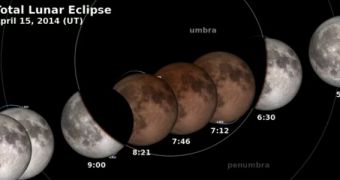Astronomers at NASA say that their Lunar Reconnaissance Orbiter (LRO) will experience a total lunar eclipse in the early morning hours of April 15. This event will also be visible from North America as well as other parts of the Western Hemisphere. Total eclipses occur when the Sun, the Earth, and the Moon are in perfect alignment and the Moon passes behind our planet, blanketed in its shadow.
Lunar eclipses are not uncommon, scientists say, especially during a full moon. Such phenomena occur several times every year, but this particular event will be different due to the fact that it will be visible prominently and in its entirety from North America. The next time this will be possible is in 2019, when an eclipse will again happen during the night, making for excellent viewing conditions.
Total lunar eclipses will happen before 2019, but due to the Moon's orbital path, these events will be prominently visible from other parts of the world, not the United States and Canada. On Tuesday, April 15, the eclipse will last for around three hours, and will begin at around 2:00 am EDT (0600 GMT).
If you stay up to witness the event, some of the changes in lunar appearance you can expect include a phenomenon that will make it seem as if the Moon is changing phases within a matter of minutes, instead of weeks. This occurs when Earth's natural satellite enters the shadow our planet projects behind it, also known as the penumbra, and resembles a shadow passing on the lunar surface.
Sometimes lunar eclipses will “happen and you'll have to be somewhere else on Earth to see them. Most [residents] of the continental United States will be able to see the whole thing,” explains Noah Petro, the deputy project scientist for the LRO mission at the NASA Goddard Space Flight Center (GSFC) in Greenbelt, Maryland.
Taking about the Moon's passing through the penumbra, Petro says that “eventually there will be a chunk of darkness eating the Moon.” When the eclipse reaches its peak intensity, at around 3:45 am EDT (0745 GMT), the natural satellite will catch on reddish hues, similar to those we see at sunset.
This phenomenon is caused by our atmosphere, which scatters red light in the visible portion of the electromagnetic spectrum. This scattered light will then bounce of the Moon, making it appear red, as described in the video below. “It's a projection of all the Earth's sunsets and sunrises onto the Moon,” Petro goes on to say.
“It's a very subtle effect, and if any part of the moon is illuminated in the Sun, you can't really see it,” the expert adds. According to GSFC investigators, the event will not affect the LRO in any way, even though the orbiter will be deprived of sunlight for longer than usual. The spacecraft will be going straight from the moon's shadow to the Earth's shadow while it orbits during the eclipse,” Petro adds.
In order to safeguard the spacecraft, GSFC mission controllers will turn off some of its instruments and will monitor its vital signs as often as possible, most likely once every few hours. “For quite a while, people in LRO have been analyzing what's going to happen during this eclipse. We'll make sure the world knows LRO survived with no problems,” Petro concludes.

 14 DAY TRIAL //
14 DAY TRIAL // 